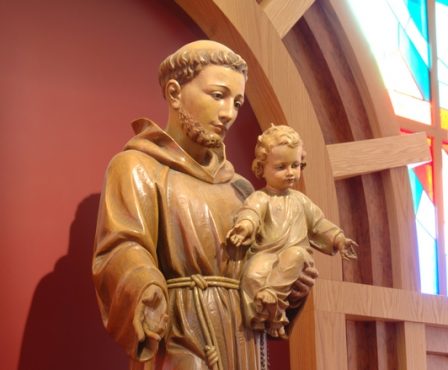
Saint Anthony of Padua
Antoine de Padoue was born in Lisbon around 1195. He entered the regular canons of Saint Augustine and remained eleven years at the monastery of Saint Croix in Coimbre. In this renowned centre of theological studies he acquired a marvelous knowledge of Sacred Scripture and the Fathers. Desirous of martyrdom, he passed in 1220 to the Friars Minor. He actually went to Morocco but had to leave him for illness. Then he led a life of high contemplation in Monte Paolo (Romagna) He then devoted himself to preaching and experienced an incredible success, confirmed by brilliant prodigies.
The sermons of St Anthony are addressed sometimes to the faithful in general, sometimes to classes of people: penitents, active, contemplative, religious, preachers, prelates, etc.; at each of these classes, our Holy One traces the way of salvation and perfection. He showed himself everywhere an admirable safety and correctness of doctrine; nevertheless he avoided speculation and was always eminently practical. From time to time he interrupted the apostolate to immerse himself in contemplation, where God granted him mystical graces. He also held several positions in the Order and taught theology to his young confreres. Antoine died in Padua on June 13, 1231 and was canonized on May 30, 1232. In 1931, on the occasion of the seventh centenary of the death of our Saint, the Friars Minor asked the Holy See to honour Saint Anthony with the title of Doctor of the Church.
The dossier will be presented in 1936, decorated with 2017 signatures from all over. On January 16, 1945, St Anthony was appointed Doctor of the Universal Church.

Why pry St-Anthony?
St Anthony of Padua is undoubtedly the most venerated and prayed saint in the world. But why is he prayed to? What are people asking him for?
Following a very old tradition, going back to an episode of his life, St Anthony is invoked to find lost objects. Delicate attention to the Saint, when we think of the anguish of those who have lost a precious document or the key to the house, a trunk, the car, etc… But an approach in truth with St Anthony also leads to the rediscovery of faith and religious practice, to the strength and courage to face the trials of daily life as for example: an illness, a divorce, the loss of a loved one.
Is he not himself a master of theology and a model of spiritual life, always close to God and men? Beyond the prayers we can address to him, it is above all his message that we can remember.

Lost thing
This is undoubtedly one of the most frequent reasons why St Anthony is invoked: to find lost things. Where can this come from? Some biographers think it could be traced back to an incident likely to have occurred in the life of the saint. Indeed, it is said that Anthony had a psalter all annotated with his own hand and that he used to give courses in Sacred Scripture to his confreres. Now a novice, who wanted to leave the Order, seized the precious volume and left. Anthony, for his part, prayed to find his psalter. Indeed, a little later the novice, repentant, reported the said volume and even re-entered the Order.
There is also a hymn composed in honour of St Anthony and who knew the most astonishing of fortunes. Julien de Spire, in his hymn Si quaeris miracula, which means: If you seek miracles, says that St Anthony gives back to those who pray to him the lost members and forces, in Latin: membra viresque perditas. In the course of time, we do not know why, the first syllable of viresque would have disappeared, leaving only resque. But then the meaning is changed and becomes: the lost limbs and things, instead of: the lost limbs and forces. Saint Anthony grabs the new meaning of the phrase as if it were stolen and sets out energetically in search of lost things. One thing is certain: it works great, even though sometimes, it also finds lost people. Why not?
The lily of St-Anthony
t is legitimate to ask where devotion to the lilies of St Anthony comes from, since devotion does indeed exist. Here is what we have gathered on this subject. I leave it, of course, to your complete discretion. During the Italian Revolution, the Franciscans of the city of Marcasso in Sicily were expelled from their convent. The church, which remained open, remained deserted. Once a year, the surrounding population came there for the feast of Saint Anthony. Many flowers of all kinds were brought on this occasion. There were especially roses and lilies.
Before leaving, each one brought home a flower which was kept as a precious memory. One year, the sacristan forgot to place the statue of the Saint in its niche. A few weeks later, he returned to repair his forgetfulness. But what was not his surprise: at the foot of the statue was a sheaf of lilies of incomparable freshness. The astonishment was all the greater as the other flowers abandoned on the spot were completely dried up. The new one snowballed and they wanted to see with their eyes these admirable lilies, while the season of the lilies was well and truly over.
A similar miracle is said to have occurred in Mentosca, Austria, in 1630. A lily had been placed in the hand of St.Anthony for the feast of June 13. Left there all year, he kept his freshness and continued to spread his perfume. Pope Leo XIII himself granted a special blessing of the lilies of Saint Anthony for the feast of the Saint.
Le bref de Saint-Antoine
A woman from Portugal, in the throes of the demon’s vexations, did not know where to give more head. Even that one day her husband called her possessed by the demon. No longer wanting it, she decided to end her life, throwing herself into the river. Along the way, she passes in front of the Franciscan church and stops there for a last prayer. It was June 13. During her prayer, she falls asleep, and suddenly Antoine appears to her, with a paper in his hand: «Take this note and he will deliver you». Now, the note had this quotation from Revelation: «Behold, the lion of the tribe of Judah, the offspring of David, has prevailed, that he may open the book, and open the seals thereof».
When she wakes up, surprised to find herself with a bill in her hand, she regains confidence and returns home completely healed. It is not known how this parchment reached the king of Portugal who greatly facilitated its dissemination. It was a brief formula – hence the word BRIEF – but effective in the hands of all who believe. This devotion to the Brief of St.Anthony is still very popular today and most people who have one carry it on them.

The bread of the poor
This happened in Padua, in the Middle Ages. A child left alone for a while, plays in the water and drowns. On the way back, the mother looks for her child and finally finds him, but without life. Franciscans who supervised the construction of the Basilica came and consoled the poor woman as best they could. The child is still dead, but the mother’s faith is surprisingly alive. She makes the following promise to St Anthony: if the child comes back to life, she will give the poor as much bread – other stories say as much wheat – as the weight of the child. We pray a lot and towards the end of the night the child comes back to life. Such would be the origin of the work of the bread of the poor that was nicknamed in time the pondus pueri or the weight of the child. Until the 19th century, the prodigy was almost forgotten. But at the end of the same century, thanks to the adventure that happened to Louise Bouffier, he resurfaced.
On May 12, 1890, Louise was unable to open the door to her store. The lock was broken. Even the locksmith, out of patience, suggested breaking down the door. At the last moment, the lady changed her mind and said to the locksmith: Try this key again. If it succeeds, I promise Saint Anthony as much bread as I can». It works! From there spread the habit of collecting bread for the poor against favor obtained.
The stamp of Saint-Antoine
The use of the stamps of Saint Anthony without postal value was adopted by the friends of Saint Anthony. In Canada, it is used a bit like the Brief or the lily, as a sign of confidence. In other countries, instead of putting a stamp on a letter or a parcel entrusted to Saint Anthony, we simply write in three letters RSA or SAG, which means in a way: that Saint Anthony guides you or keeps you.
On the other hand, we know that in 1931, on the 700th anniversary of the death of the Saint, stamps were printed in Portugal and Italy in honour of Saint Anthony. All this to say that the association between Saint Anthony and the post office may be due to another incident of his life. But which one? Some say that one day Anthony, desiring to go to San Pietro to rest and reflect, wrote a letter to his superior asking his permission. When he entrusted the letter to a messenger, he no longer found it. Believing that it was a sign of God’s will, he renounced his plan. However, a few days later, he received permission from his superior. It remains to be explained how his superior had been informed. In the same vein, it is said that one day a certain Dante left his wife in Spain to go to Peru. She often wrote to him without ever receiving an answer. Discouraged, she wrote another letter and placed it in the hands of Saint Anthony in a Franciscan church. She returns the next day and the letter is still there. She complained loudly about it, which led to the arrival of the sacristan who claimed to have been unable to remove this letter from the hands of the Saint. Then the lady, very easily, takes the letter and realizes that it is no longer her letter but the letter-reply of her husband, who will later affirm that his wife’s letter had been given to him by a Franciscan father.
But who could this Franciscan father be? Saint Anthony himself?
